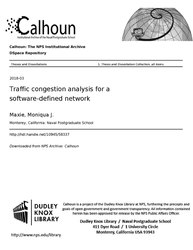File:Traffic congestion analysis for a software-defined network (IA trafficcongestio1094558337).pdf

Original file (1,275 × 1,650 pixels, file size: 1.91 MB, MIME type: application/pdf, 74 pages)
Captions
Captions
Summary[edit]
| Traffic congestion analysis for a software-defined network
( |
||
|---|---|---|
| Author |
Maxie, Moniqua J. |
|
| Title |
Traffic congestion analysis for a software-defined network |
|
| Publisher |
Monterey, California: Naval Postgraduate School |
|
| Description |
The objective of this thesis is to implement an anomaly-detection method that can be used to detect congestion in a software-defined network. The method incorporates spectral graph theory and phantom node techniques. The experimental implementation of spectral graph theory used eigenvalue-eigenvector solutions to characterize a mathematical model of the network’s topology. In this thesis, we used the phantom node technique to determine congestion in the network by using a virtual node to set the threshold for available link capacity, or the maximum amount of traffic, that can cross the links in the network before the links are considered congested. Results show that when the network is congested, a shift occurs in the eigenvalue and eigenvalue index spectrum. Prior to congestion, the virtual node has the highest nodal influence in the lowest eigenvalue index; however, when a node becomes congested and high traffic in the node crosses the threshold set by the virtual node, the congested node takes the position of the virtual node in the eigenvalue index. The virtual node shifts to having the greatest nodal influence in the next-higher eigenvalue index in the spectrum. Essentially, the results show that anomalies, such as congestion, can be detected using the anomaly-detection method developed in thesis. Subjects: cyber; software defined network; phantom node; congestion |
|
| Language | English | |
| Publication date | March 2018 | |
| Current location |
IA Collections: navalpostgraduateschoollibrary; fedlink |
|
| Accession number |
trafficcongestio1094558337 |
|
| Source | ||
| Permission (Reusing this file) |
This publication is a work of the U.S. Government as defined in Title 17, United States Code, Section 101. Copyright protection is not available for this work in the United States. | |
Licensing[edit]
| Public domainPublic domainfalsefalse |
This work is in the public domain in the United States because it is a work prepared by an officer or employee of the United States Government as part of that person’s official duties under the terms of Title 17, Chapter 1, Section 105 of the US Code.
Note: This only applies to original works of the Federal Government and not to the work of any individual U.S. state, territory, commonwealth, county, municipality, or any other subdivision. This template also does not apply to postage stamp designs published by the United States Postal Service since 1978. (See § 313.6(C)(1) of Compendium of U.S. Copyright Office Practices). It also does not apply to certain US coins; see The US Mint Terms of Use.
|
 | |
| This file has been identified as being free of known restrictions under copyright law, including all related and neighboring rights. | ||
https://creativecommons.org/publicdomain/mark/1.0/PDMCreative Commons Public Domain Mark 1.0falsefalse
File history
Click on a date/time to view the file as it appeared at that time.
| Date/Time | Thumbnail | Dimensions | User | Comment | |
|---|---|---|---|---|---|
| current | 13:33, 25 July 2020 |  | 1,275 × 1,650, 74 pages (1.91 MB) | Fæ (talk | contribs) | FEDLINK - United States Federal Collection trafficcongestio1094558337 (User talk:Fæ/IA books#Fork8) (batch 1993-2020 #30826) |
You cannot overwrite this file.
File usage on Commons
The following page uses this file:
Metadata
This file contains additional information such as Exif metadata which may have been added by the digital camera, scanner, or software program used to create or digitize it. If the file has been modified from its original state, some details such as the timestamp may not fully reflect those of the original file. The timestamp is only as accurate as the clock in the camera, and it may be completely wrong.
| Short title | Traffic congestion analysis for a software-defined network |
|---|---|
| Author | Maxie, Moniqua J. |
| Software used | Maxie, Moniqua J. |
| Conversion program | Microsoft® Word 2016 |
| Encrypted | no |
| Page size | 612 x 792 pts (letter) |
| Version of PDF format | 1.4 |

